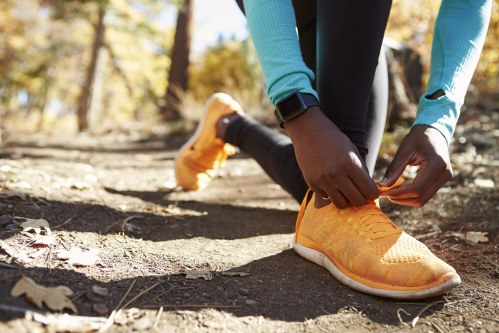Wait, have I been wearing the wrong shoe size my whole life?
Chances are you've been wearing the wrong shoe size. Fortunately, it takes just three easy steps to find the perfect fit for your feet.

The perfect pair of kicks can start a revolution. However, the opposite can lead to your downfall. If your toes feel like they’re being suffocated, or your heels are popping out with every step, you’ve probably got the wrong shoe size.
On Thursday, Nike announced the impending summer launch of Nike Fit, a new feature of the company’s mobile app that scans your feet to determine the best size shoe in every pair of Nike sneakers. Michael Martin, vice president of Nike direct products, growth and innovation, says the new tricked-out app addresses a common problem.
“For [Nike] shoes bought online, 27 percent of them are returned because of bad fit,” he tells Well+Good, noting that the figure likely falls short of estimating the number of runners, walkers, weightlifters, and everyday athletes going about their daily lives without perfect companions for their feet. Why? It doesn’t account for those who can’t be bothered to return the shoes, or those who stick it out with a pair they’ve mistaken for their sole-mate. “People are so accustomed to their shoes fitting one way or another that they’re just sort of resigned to the fact,” he says. Nike’s app seeks to remedy that.
While a specific launch date has yet to be announced, we’re putting our foot down now—we will no longer wear shoes that don’t fit us! Period! The end! Not only is it plain uncomfortable to feel out of sync with your own sneaks, but ill-fitting shoes can cause a plague of orthopedic problems. Wearing trainers that are too tight, for example, could cause bunions, hammer toes, corn calluses, and ingrown toenails, says the American Academy of Orthopedic Surgeons. So going the extra mile to get it right will pay off in spades for your poor, aching feet.
“For shoes bought online, 27 percent of them are returned because of bad fit.”
According to Running Warehouse, some old-school crafting proves one of the easiest ways to put an end to sizing confusion (besides getting an in-store measurement at an athletic store, of course). You’ll just need a piece of paper and a pen. Then slip off your shoes so you’re standing in just socks and trace around your foot. Once you have your drawing, take a ruler and measure both the length and width of your foot. Refer to this chart to see how your measurements add up to both American and European sizes. Before you run off into the sunset with your new shoes, however, Road Runner Sports recommends going up a half size in running-specific shoes (as you’ll see illustrated on the chart). And, there you have it, you’ve found your match.
Of course, even the best-laid DIY projects reap unsatisfying results. So if you wear your shoes for a few weeks and start to notice they’re just not working for you, take advantage of generous exchange policies offered by the world’s premier athletic shoe companies. Brooks Running, for example, offers a 90-day return policy for worn-and-rejected gear. Nike’s is slightly less forgiving at 30 days. Brick-and-mortar exercise stores, like Fleet Feet, usually have some kind of satisfaction guarantee.
We all strive to walk in other people’s shoes, but not when the consequences are blisters, bunions, and a whole lot of unsatisfying workouts.
Now that you’re an expert at finding your perfect fit, get it on these neon sneaks or these minimally-designed stunners.
Sign Up for Our Daily Newsletter
Get all the latest in wellness, trends, food, fitness, beauty, and more delivered right to your inbox.
Got it, you've been added to our email list.










